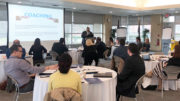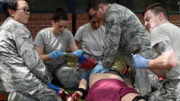As community colleges work to prepare their students to transition to four-year programs and employment, they are finding new ways to allow them to earn credit for training that typically doesn’t count toward traditional degrees.
Some five million Americans annually take non-credit courses, according to a recent report by the higher education research firm JFF, which offered recommendations to increase the value of the courses and connect them to traditional higher education. Increasingly, community colleges are doing just that.
“It is illogical when non-credit course work is not applied towards credit course requirements for a degree program, forcing students to re-learn previously mastered material in a credit-bearing course,” says Tonjua Williams, president of Florida’s St. Petersburg College (SPC), which began to examine the issue nine years ago.
Williams will provide details on SPC’s approach in a May 12 workshop on noncredit-to-credit pathways held at AACC Digital, the American Association of Community Colleges virtual conference that will run workshops and sessions on Wednesdays and Thurdays in May. (Register today for AACC Digital.)
Michael Baston, president of Rockland Community College in Suffern, New York, and a co-presenter with Williams, says the high unemployment rate and low wages currently for people without degrees reinforces a need to address the issue, along with the fact that two-thirds of jobs require postsecondary degrees and 36 million Americans have enrolled in higher education but are not currently attending.
“If a portion of the ‘some college, no degree’ population were to get credit for their non-credit work through credentialing, imagine the positive impact it would have on lowering unemployment rates and increasing the weekly earnings for many,” he says.
Baston notes that solving the problem also could give students more flexibility with, and control over, their schedule, cost them less, ease their transition back into an academic environment where there are more supports, and speed them into employment.
About non-credit work
Noncredit courses typically lie in workforce training programs and developmental education like adult basic education, remedial courses and GED preparation, along with English as a second language programs. The JFF report says that the courses often “undergo extensive institutional accreditation processes” and, while they may be condensed, regularly are as rigorous as credit courses.
Beyond that, Williams notes that they can serve as pathway for students to an institution’s degree programs, and the JFF report notes that they may meet critical needs in the workforce and bring state training support funds to community colleges.
“Colleges are now more than ever examining how non-credit workforce education fits into the larger system of career pathways,” Williams says. “Non-credit programs can provide an on-ramp into a career pathway leading to upward economic mobility for students who typically would not be pursuing higher education.”
Marcia Ballinger, president of Lorain County Community College (who also will participate on the AACC Digital panel), agrees. The Ohio college developed a Fast Track program that offers short-term training certificates for in-demand fields such as IT, healthcare and manufacturing.
“These programs offer credit or non-credit options, and we have had more than 400 people earn credentials during the past year,” Ballinger says. “The best part is that more than half of these students have decided to continue their education either at the associate’s degree level or for a more advanced degree.”
Alignment is key
There are several ways the pathway between non-credit and credit courses could be improved, but Williams recommends that institutions begin slowly.
“Identify the credentials you want to tackle – start with easy ones that are known to lead to industry-recognized certifications,” she says.
As a first step, colleges should align non-credit courses to the curriculum in one of their specified majors, Baston says, and align skill levels and prerequisites.
A recent report from Education Strategy Group (ESG), an education consulting firm, says colleges should examine “structural barriers” and develop new systems to improve connections.
“Newly merged divisions can facilitate pathway development and student progression between non-credit certificate and degree programs, acting as one unit with seamless coordination, communication, and collaboration,” the report says.
It notes a case study in which Prince George’s Community College (PGCC) in Maryland created a teaching, learning and student success division which brought together credit programs, non-credit programs and student services.
“As a result, PGCC has been able to significantly reduce duplication offered across non-credit and credit programs, and early evidence shows an uptick in student demand for certain credit-bearing courses,” the report says.
It also recommends “bridge tools” to help align programs, such as equivalency agreements, articulation agreements, competency-based education, credit by exam or other prior learning assessment or credit matrices.
“We look at learning outcomes and content at the finest possible level to see where there might be overlap to be able to provide credits toward a degree and potentially accelerate completion,” Williams says. “We worked with faculty experts to identify any skill gaps and redesigned courses around the crosswalks.”
Baston adds that faculty buy-in is key in such efforts.
Making connections
Faculty members and division deans were critical in a program Lorain County Community College piloted called ITAG (Industry Transfer Assurance Guide) to create a crosswalk between industry-recognized training and credentials with college-level coursework, according to Ballinger, who notes that the program is spreading statewide.
“Students meeting credentialing requirements, regardless of where the learning was achieved, will be eligible to earn credit for specified courses deemed equivalent by faculty and endorsed by Ohio’s public institutions of higher education to the stated industry-recognized credential,” Ballinger says.
Williams says Florida’s SPC also is working to create articulation agreements with other institutions, including area high school career programs.
ESG’s report describes the development of “mirrored” courses between a Mt. San Antonio College and Long Beach City College in California where noncredit and credit courses feature identical syllabi, learning objectives and faculty qualifications. Students in each attend class together and complete identical assignments and earn equal credit.
“Mirrored courses offer students exposure to the demands of credit courses without the high stakes,” the report notes. “They also create transparency across what can often be a confusing credit articulation landscape.”
Stackable credentials also pave the way for a smoother connection between credit and non-credit course, Williams notes. She recommends embedding “all industry certifications and college career certificates and making their connections clear on the pathway as additional on and off ramps.”
The ESG report says with effective stackable credentials, each one “builds on the previous one, enabling students to develop skills that help them find a job quickly, but also creating an easy access point for reentry if students choose to continue on for a more advanced credential or degree.”






